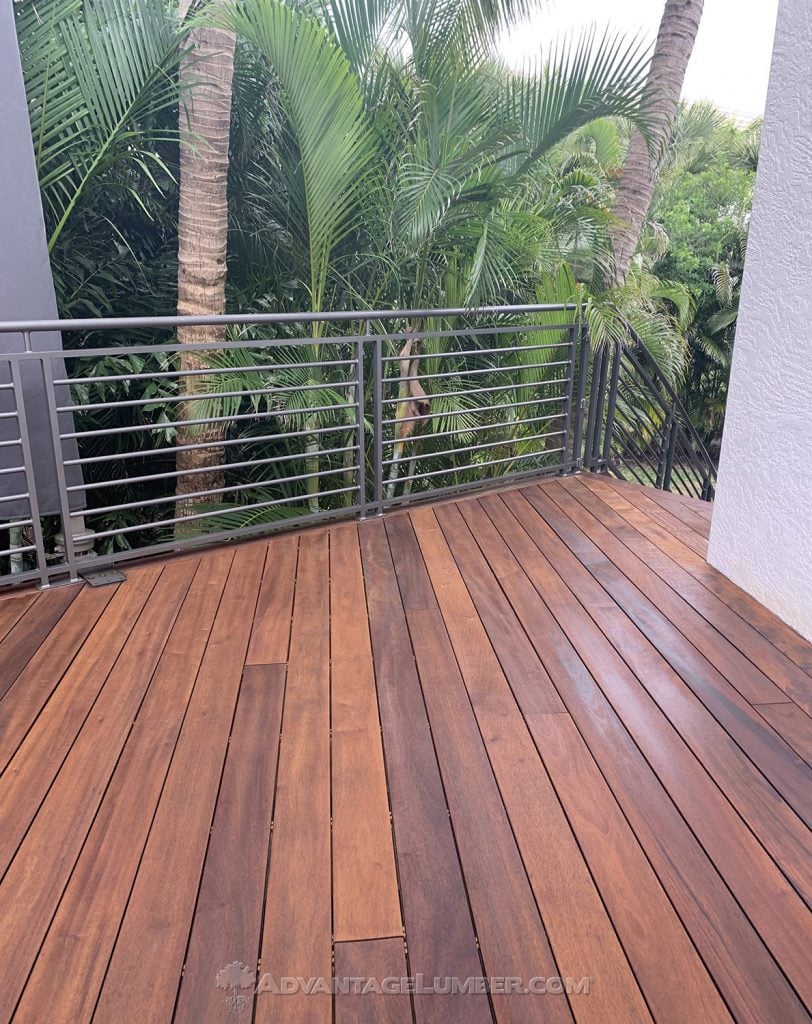When it comes to building a wood fence, the lifespan of the fence is a crucial consideration. The durability, maintenance, and initial cost of the wood are important factors to think about.
In this post, we’ll explore how long a wood fence can last, focusing on several popular wood species: pressure-treated pine, cedar, Ipe, Cumaru, and Tigerwood.
Pressure Treated Pine

Pressure-treated pine is one of the most commonly used woods for fences due to its affordability and resistance to rot and pests. The wood is treated with chemicals that prevent deterioration caused by outdoor elements and insects.
On average, a well-maintained pressure-treated pine fence can last between 10 and 15 years. The newer treatments used in pressure treated lumber do not seem to preserve the wood as long. Previously CCA which contained arsenic was used to preserve pressure treated pine and that lumber was known to last 20+ years.
Now we receive calls on a regular basis from customers that have used the newer pressure treated lumber that need to replace it after 10 – 15 years. That being said it is more important if you do use pressure treated to use a quality sealer that prevents water penetration.
It’s also important to keep up with regular maintenance, including staining and sealing, required to maximize its lifespan and keep it looking fresh. There are many home owners that neglect their maintenance for several years and experience early rot and decay.
If you feel you might fall into this category of busy home owner it’s wise to consider one of the wood species below which offer more natural rot resistance.
Cedar

Cedar is another popular choice for wood fencing due to its natural beauty and durability. Cedar naturally resists decay, rot, and some insect infestation, making it a reliable option for outdoor structures.
With proper care, a cedar fence can last between 15 to 20 years. Cedar’s oils also make it resistant to weather conditions, but like pine, it benefits from occasional staining and sealing to maintain its color and protective properties. A good water sealer will help repel the water and extend the lifespan of the wood.
Ipe

Ipe, a hardwood from South American forests, is exceptionally durable and dense, which makes it an excellent choice for fencing. Ipe has a natural resistance to rot, decay, and insect attacks, and it’s also highly resistant to fire.
An Ipe fence can last up to 75 years with minimal maintenance, although its dense nature makes it more challenging and expensive to install. Since Ipe naturally resists rot and wood boring insects it does not need water sealers to protect it from rotting.
The only maintenance Ipe wood needs is rolling or spraying on a UV oil like Ipe Oil to keep it’s rich brown color. UV rays will turn all wood grey but the Ipe Oil protects the wood and when it starts fading usually after a year you simply apply more oil. The oil does not peel and flake off like water sealers on Pressure treated so this is much lower maintenance.
Cumaru

Similar to Ipe, Cumaru is another dense, tropical hardwood that boasts longevity and durability. It shares many of the beneficial properties of Ipe, including resistance to rot, decay, and insects.
A Cumaru fence can be expected to last for upwards of 50 years or more when properly installed and maintained. It is less expensive than Ipe but offers a similar level of durability and a slightly different aesthetic, with a richer, reddish-brown color.
Tigerwood

Tigerwood is yet another exotic hardwood known for its striking appearance and durability. It features a unique grain pattern with vibrant color variations ranging from reddish-brown to light orange. Like the other tropical hardwoods mentioned, Tigerwood is highly resistant to rot, decay, and insect infestation.
A fence made from Tigerwood can last over 30 years with the same exact maintenance as Ipe and Cumaru. If you wish to keep its exotic look may require the use of a wood cleaner and brightener to keep the grain variation and tiger stripe look.
Tigerwood is photosensitive and as it gets exposed to UV rays it will gradually mellow out and turn a more rich brown color and show less of the variation in the grain which is plus for those that don’t like the variation. For those that like the variation you can apply DeckWise cleaner & brightener with a pump sprayer and then power wash the fence and it will restore the original color.
Below is a picture of and aged Tigerwood deck that shows how it look after it has been exposed to UV rays for awhile. It mellows out the color and grain variety and you can still see lots of beautiful grain however the color looks more consistent now.

Conclusion
The lifespan of a wood fence greatly depends on the material used, the climate it is exposed to, and how well it is maintained. Pressure-treated pine and cedar offer a more cost-effective solution but typically require more maintenance. On the other hand, hardwoods like Ipe, Cumaru, and Tigerwood provide a longer lifespan with minimal upkeep, though at a higher initial cost.
Choosing the right wood for your fence involves weighing these factors along with your budget and aesthetic preferences. Regardless of the wood type you select, regular maintenance is key to ensuring that your fence remains beautiful and functional for as long as possible.
